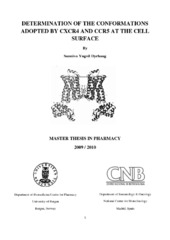Determination of conformations adopted by CXCR4 and CCR5 at the cell surface
Master thesis
Permanent lenke
https://hdl.handle.net/1956/4223Utgivelsesdato
2010-05-20Metadata
Vis full innførselSamlinger
Sammendrag
The chemokines and their receptors constitute many important physiological functions in the human body. The chemokine receptors belong to the family of G-protein coupled receptors, characterized by 7 α-helices penetrating the cell membrane, and are coupled to a heterotrimeric G-protein intracellularily. Discovering the phenomenon of oligomerization of the G-protein coupled receptors, increased the complexity in terms of functionality and dynamics significantly, amplifying both challenges and possibilities related to these receptors. The chemokine receptors CCR5 and CXCR4 are physiologically diverse and in addition, the two co-receptors for HIV-1. HIV-1 infects T cells through an envelope protein called gp120, which binds to CD4 on the target cell, in addition to CCR5, CXCR4 or both, depending on the strain of the virus in question. M-tropic HIV-1 gp120 enters and infects monocytes via CCR5, while the T-tropic HIV-1 p120 enters and infects lymphocytes via CXCR4. Another dual tropic strain, entering via both chemokine receptors also exists. Evidence has been published, which indicates a possible effect on HIV-1 infection related to receptor oligomerization dynamics, based on the presence of several receptors capable of forming oligomeric complexes at the cell membrane. In this project, cell functionality and receptor expression pattern of CCR5 and CXCR4 fused with a fluorescent protein (CFP or YFP) is demonstrated. In addition to this, homo- and heterodimerization between CCR5 and CXCR4 in live cells are demonstrated by the use of Fluorescence Resonance Energy Transfer (FRET). By the same technique, it is also demonstrated that CCR5 is able to decrease the apparent affinity of CXCR4 towards forming homodimers, indicating the conformation dynamics of these receptors. Finally, the importance of CXCR4 conformations in terms of T-tropic (X4) HIV-1 entry is assessed, as it is demonstrated that the presence of CCR5 at the cell surface decreases T-tropic (X4) HIV-1 infection significantly, most likely by interacting with CXCR4 and altering its conformation.
Utgiver
The University of BergenOpphavsrett
Copyright the author. All rights reservedThe author
